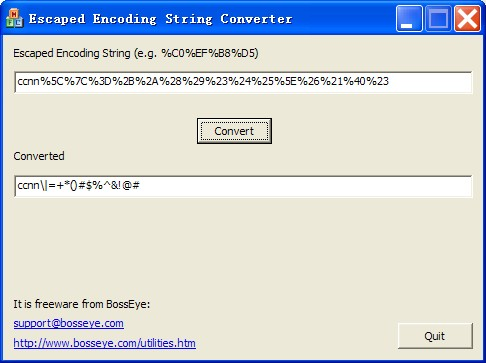URL Escaped Encoding Decoder
- Category
- Programming
- Editors

- Developer: BossEye Inc.
- Home page: www.bosseye.com
- License type: Free
- Size: 125.6 KB
- Download
Review
It is used to decode the Escaped-encoding URL. Escaped-encoding, or sometimes referred to as percent-encoding, is the standard of representing characters within a URI that may need special syntax handling to be correctly interpreted. It uses a sequence of three characters to encode the character to be interpreted. This triplet sequence consists of the percentage character ¡°%¡± followed by the two hexadecimal digits representing the octet code of the original character. For example, the US-ASCII character set represents a space with octet code 32, or hexadecimal 20. Thus its URL-encoded representation is %20. Applications may automatically escape reserved and unreserved characters, or automatically un-escape an escape-encoded sequence within a URI, if there is potential for it to be incorrectly interpreted by the remote application. This conversion may be due to the position of the character or escape-encoded sequence within the URI. For example, "%7e" is sometimes used instead of "~" in an http URL path, but the two are equivalent for an http URL. Because the percent "%" character always has the reserved purpose of being the escape indicator, it must be escaped as "%25" in order to be used as data within a URI. The RFC for URI encoding recommends that care should be taken not to escape or un-escape the same string more than once, since un-escaping an already un-escaped string might lead to misinterpreting a percent data character as another escaped character, or vice versa in the case of escaping an already escaped string. Useful Character Escape Code: SPACE %20 < %3C > %3E # %23 % %25 { %7B } %7D | %7C \ %5C ^ %5E ~ %7E [ %5B ] %5D ` %60 ; %3B / %2F ? %3F : %3A @ %40 = %3D & %26 $ %24